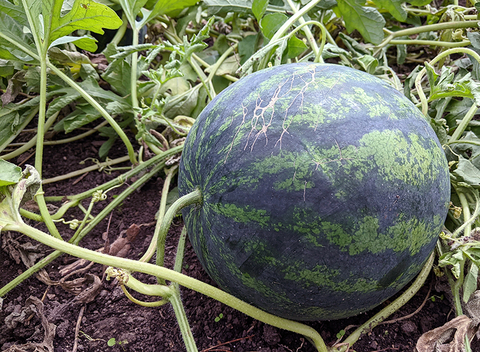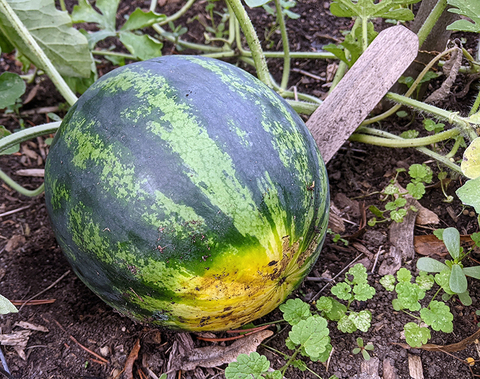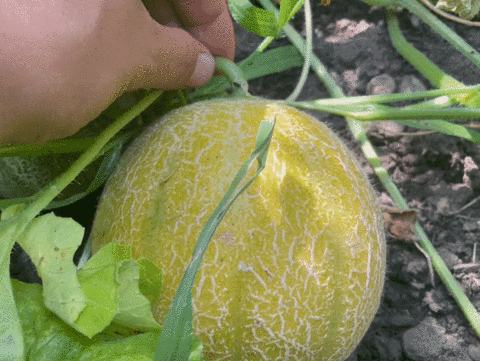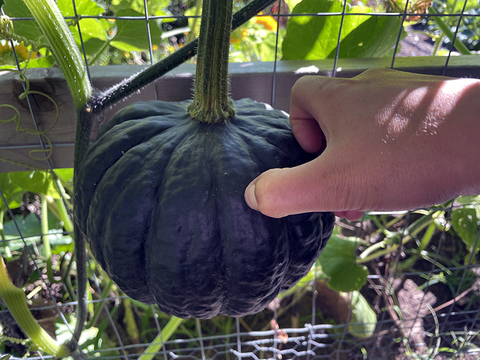Guidelines for harvesting cucurbit crops like watermelons, melons and squash are confusing and often contradictory. Farmers and gardeners often struggle to pick melons at the right time, and find that they are either flavorless or mushy and overripe.
This is a quick guide to harvesting cucurbit crops for optimal ripeness.
Ripening basics
Fruit and vegetables are typically assigned to two categories that define their ripening behaviors.
Fruits and vegetables that continue to ripen off the vine
You can harvest these fruits and vegetables before they are fully ready and they’ll continue to ripen on your kitchen counter. Common examples of fruits that ripen off the vine include apples, bananas, peaches and tomatoes. This trait is sometimes referred to as "climacteric."
Fruits and vegetables that do not ripen after harvest
Once removed from the plant, the sugar content of these fruits and vegetables will not increase, and so picking at exactly the right time is important for flavor. These fruits and vegetables can still go bad if left out, but they tend to have a longer shelf life, and they will not get sweeter. Examples include grapes, strawberries and watermelon. This trait is sometimes referred to as "non-climacteric."
Sometimes ripening is not so black and white, and this is especially true in melons. Ripeness is determined by a variety of traits including sugar content, how easily the fruit detaches, ethylene production and firmness of the skin.
Watermelons
Watermelons all belong to the same species, Citrullus lanatus. They were likely domesticated in the area around Libya and Egypt. Watermelons do not ripen after harvest and should be left on the vine until they are fully ripe.
Signs of ripeness include:
- The spot where the fruit touches the ground becomes more prominent and changes color (typically yellow).
- The tendril closest to the fruit becomes brown and dries up.
- Ripe melons have a hollow, dull sound when tapped.
- The sheen of the rind tends to change slightly with maturity, but this depends on the variety.
- Watermelons do not reach “full slip.” This is a term you might see in seed catalogs, which refers to the time when a melon can easily be slipped from the vine.
Watermelons are sensitive to ethylene, and so they should be stored separate from ethylene producing crops like tomatoes, bananas, apples or cantaloupe in order to extend the shelf life.
Melons
"Melon" is a vague word in English; many other languages have distinctly different terms for the fruit belonging to the species Cucumis melo subspecies melo, and for watermelon, bitter melon, and other related but distinct cucurbits. Melon in this article refers to the Cucumis melo subspecies melo, which contains hundreds of distinct cultivars including cantaloupe and honeydew.
Melons originated in both Asia and Africa, with the oldest known melons dating back to China in 3000 BC, and lower Egypt in 3700 BC.
Within these species, some varieties ripen off the vine and some do not. While this is not a comprehensive summary, here is the main advice for farmers:
Cantaloupe
The primary varieties of cantaloupe-style melons in the U.S. often have netted rinds, but not always, and they vary from lobed to smooth. They all have a relatively high sugar content.
- Cantaloupe-style melons have been consistently bred over time to continue to ripen off the vine.
- They can be harvested at "full slip," meaning they are ripe when they easily pull away from the vine.
- It's easy for melons to become over-ripe in gardens. Cantaloupe can reliably be harvested a little bit early (before full slip) and left to ripen on the kitchen counter.
Honeydew group
Honeydew are the most well-known type of melon in the subspecies Cucumis melo spp. melo var indorus. This group also includes common melons like Piel de Sapo. These melons have an even higher sugar content than cantaloupe melons.
- For the most part, these melons do not continue to ripen off the vine. This means they will not continue to ripen or become sweeter after they are harvested.
- But some varieties of honeydew do continue to ripen off the vine. Experience with a specific honeydew variety will help you to determine ripeness. Farmers can contact their seed representatives for insight about varieties.
- They will not reach full slip, so this should not be used as an indicator of ripeness.
- Indications of ripeness vary across varieties, but common indications include rind color changes and the presence of a sweet smell.
- These melons should be fully ripe when you harvest them.
Makuwa, Chinensis and Conomon melons
(And other melons from China, Japan, Korea, and the Philippines)
This group is a bit less defined than the cantaloupe and honeydew groups, because there is more genetic variation between varieties.
- They tend to range from not ripening after harvest, to ripening very slightly, meaning they usually will not ripen or get sweeter once harvested.
- Since this group is variable, read the variety descriptions in your seed catalog, and check on these melons more often in storage.
When reading variety descriptions, check for terms like "harvest at full slip," "cut from vigorous vines when the skin begins to yellow," and "cut from vines when the skin becomes soft."
All types of melons should be stored at 95% relative humidity. Cantaloupe should be stored at 40°F, and honeydew can be stored in slightly warmer conditions, between 45 and 50°F. The crisper drawer in a refrigerator is a great place to store these melons once they are ripe.
Winter squash and pumpkins
Winter squash and pumpkins fall into three main species groups: Cucurbita maxima (kabocha, hubbard, arikara squash, and some pumpkins), Cucurbita moschata (butternut and some other winter squash), and Cucurbita pepo (pumpkins, zucchini, acorn, delicata, pattypan and summer squash).
Pumpkins and squash originated across Mesoamerica, with specific types originating across the continents in places including Argentina, Brazil, Guatemala, Mexico, Puerto Rico, and the Southern United States.
All types of pumpkins and squash do not continue ripening after harvest, and so they should be allowed to ripen to full maturity on the vine.
As pumpkins and squash ripen, the rind will become increasingly firm, and they should not dent when you press a fingernail into the skin. The vines usually also begin to decline when squash are ready, and the part of the vine immediately attached to the fruit (which will become the stem) should become hard and woody.
Harvest winter squash and pumpkins by cutting the stem with a pruning shears or sharp knife. If the stem detaches from the fruit, the shelf life will be decreased.
Winter squash and pumpkins should be cured before storing. Curing is a process where the fruit rind hardens, allowing longer storage life. Squash and pumpkins can be cured outdoors if warm (~ 80-90 °F), rainless days are forecast at harvest time. Simply sever the fruit from the rest of the plant and let it sit in the field or garden for 7 to 10 days, or until nicks and small cuts are scabbed over.
Indoor curing is recommended if weather will not be amenable to field curing. This can be done in any covered facility (like a barn or high tunnel), as long as outside air is circulated past the product. Open doors and use fans to promote airflow. As a rule of thumb, the squash is done curing once it cannot be punctured with a fingernail.
Winter squash and pumpkins should be stored at 50% relative humidity, and around 50 to 55 °F. They can last 1 to 6 months in storage, depending on the variety.
If left on your front porch, take them inside if a hard frost is projected. After sitting outdoors for a month or more, they should be eaten quickly, as outdoor conditions will decrease the shelf life.
Read more about Postharvest handling of fruit and vegetable crops in Minnesota.
This article was adapted from a more in-depth version for Fruit and Vegetable News.
Cantwell, M., Suslow, T. 2014. Pumpkin: Recommendations for Maintaining Postharvest Quality. UC Davis.
Chomicki, G., Schaefer, H. and Renner, S.S. (2020), Origin and domestication of Cucurbitaceae crops: insights from phylogenies, genomics and archaeology. New Phytol, 226: 1240-1255. https://doi.org/10.1111/nph.16015
Leida, C., Moser, C., Esteras, C. et al. Variability of candidate genes, genetic structure and association with sugar accumulation and climacteric behavior in a broad germplasm collection of melon (Cucumis melo L.). BMC Genet 16, 28 (2015). https://doi.org/10.1186/s12863-015-0183-2
Passam, H.C., Bird, M.C. 1978. The respiratory activity of honeydew melons during the climacteric. Journal of Experimental Botany, 29(109): 325-333.
Shrefler et al., 2017. Watermelon Production | Oklahoma State University
Suslow, T., Cantwell, M., Mitchell, J. 1997. Honeydew: Recommendations for Maintaining Postharvest Quality. UC Davis.
Suslow, T., Cantwell, M., Mitchell, J. 1997. Cantaloupe Recommendations for Maintaining Postharvest Quality. UC Davis.
Reviewed in 2023





